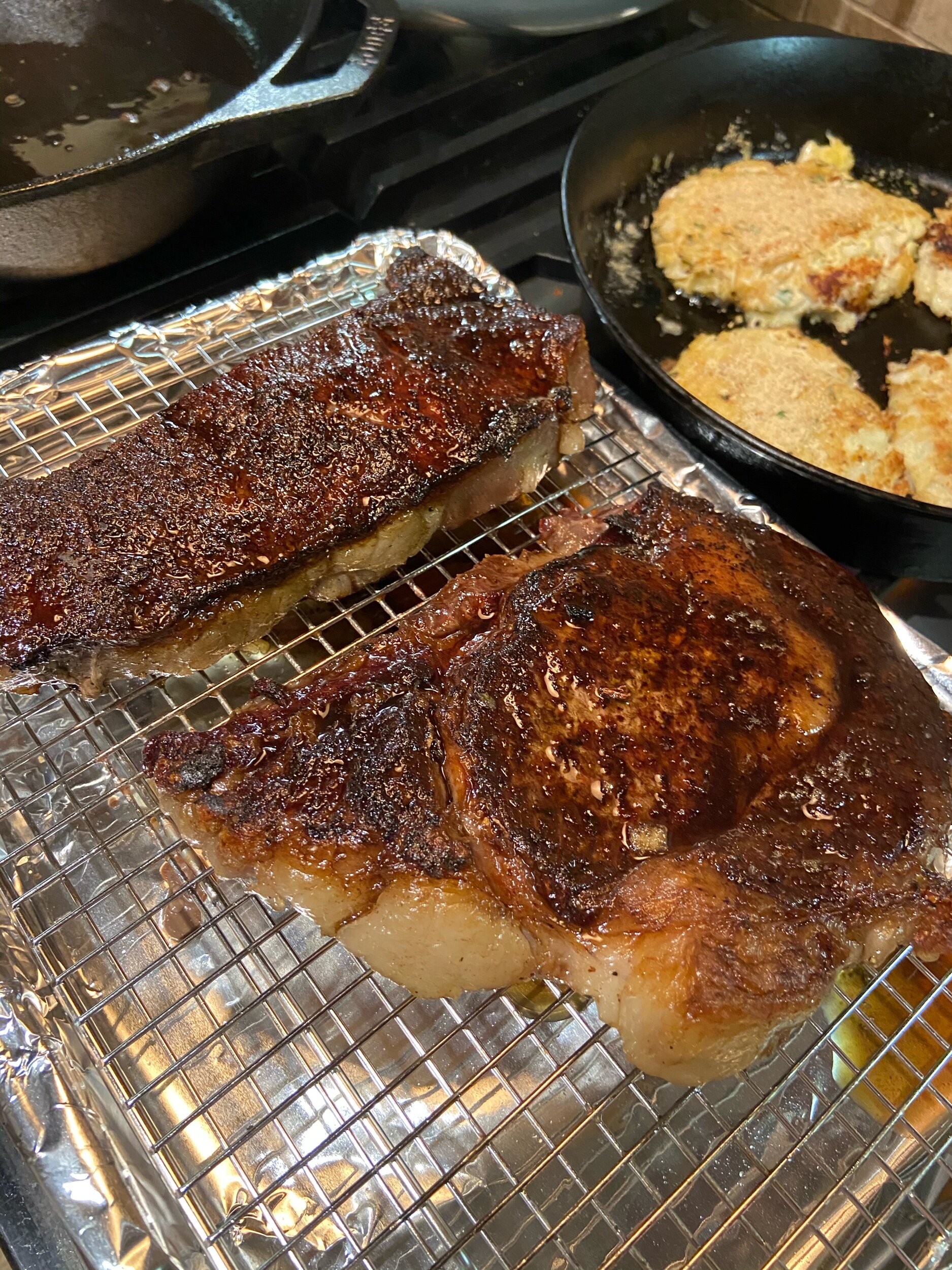Reverse Seared Steak
My husband and I have tried so many ways to make the “perfect steak.” We have burned and ruined so many beautiful ribeyes and strips. That said, throughout all of the failures, I feel qualified to say that the reverse sear is the easiest and most consistent way to properly cook a steak. With the reverse sear, you roast the meat in an oven set to a low temperature, around 200 degrees. Most ovens, especially not the one in our apartment, are not reliable any lower. This process brings the interior of the meat close to the desired internal temperature.
Using an instant-read thermometer, pull the steak out of the oven once it’s reached an internal temp roughly fifteen degrees lower than the desired final temperature. This time, I pulled the steak out at 105 degrees, targeting a rare to medium rare steak. If you prefer your steak medium-well to well-done, I would recommend you skip the preliminary roasting, and make a quick trip to Office Depot. Their cardboard is much cheaper.
A couple minutes before the steak is ready to come out of the oven, start heating a cast iron skillet over high heat. You may have heard it’s good to use a neutral oil or butter at this stage, but I don’t think it’s necessary. When you pull the steak out to sear, place the fat-cap down first to render the surface fat. Be warned, your apartment may end up looking like Willie Nelson’s tour bus, but it will all be worth it. In fact, if you haven’t already, you may want to unplug your smoke detector. This usually smokes out my entire apartment, and our roommate, Popeye, is not a fan. Check him out hiding from the smoke under our bed! Not a fan of steak night.
After you get some fat covering the bottom of the pan, lay the steak down flat and cook for around thirty seconds to a minute per side. Once you’ve given each side a preliminary sear, begin basting by adding a hunk of butter and carefully tilting the pan towards you and using a spoon to pour butter over the top of the meat. Be extra careful here, you want to avoid having the butter or steak fat fall out of the pan and into the burner. The butter helps create a crispy crust while adding good mouth feel. At this stage, you could also add rosemary, thyme or smashed garlic cloves to the butter to infuse some of that flavor into the crust.
Reverse Seared Steak
Ingredients:
2 steaks
Butter
Salt and Pepper
Rosemary, Thyme, smashed Garlic, optional
Directions:
Remove the steaks from the fridge and set on a plate to come down to room temperature. This is important because you want the steak to be at an even temperature throughout. This will help it cook more evenly. Season the steaks heavily with salt and pepper on both sides and let rest about an hour.
Meanwhile, turn your oven on to 200 degrees F. Begin setting up your on for cooking. Wrap a quarter sheet or half sheet pan with aluminum foil to make clean up easier and then set a roasting rack on top.
Place the steaks on the roasting rack and set in the oven for one hour or until you reach an internal temperature of 105 degrees F. This is a pretty low temperature and I chose that number so that it allows for the steak to cook some in the skillet later on when we sear while still maintaining a medium rare middle.
About 10 minutes before the steak is ready to pull out of the oven, begin heating a large cast iron skillet on medium high. Remove the steaks from the oven, and a pad of butter to the pan (it should sizzle vigorously) and then add in the steaks. Don’t move the steaks for about 2 minutes and then check for some browning. Flip and then add in more butter (3-4 tablespoons) along with the optional aromatics (garlic and herbs). Very carefully tilt the pan in one direction with one hand so that the butter pools up. With the other hand, use a spoon to scoop up the butter and pour over the steaks this is called “butter basting.” Cook a minute or two more. Remove the steaks from the pan and let the steak rest before serving or slicing.
Serve the steak with a sprinkling of flaky salt and a healthy serving of the Moore Food citrus salad.













